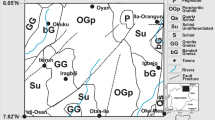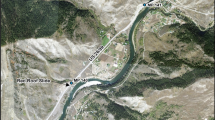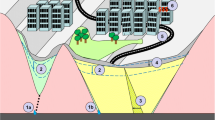Abstract
A methodology to quantify the stratigraphic uncertainty of the aquifer bottom is used in assessing the impact of sheet piles on the water table in the vicinity of a motorway. The method includes uncertainties on model parameters and depth of sheet piles. While parameter uncertainty dominates when simulating the existing groundwater conditions, the stratigraphic uncertainty dominates when predicting the impacts of the motorway sheet piles. The uncertainty of groundwater head predictions is a key element in risk assessments for infrastructure projects, where groundwater affects construction costs. While geological structural uncertainty often is a dominating source of uncertainty in large-scale water-resource studies, stratigraphic uncertainty (defined as the uncertainty of the location of geological boundaries between units/facies) becomes more important for small-scale infrastructure projects. The methodologies used so far for handling stratigraphic uncertainty typically use a somewhat simplistic approach basing the uncertainties of the geological surfaces on the kriging variance. The proposed methodology has two novel elements. Firstly, the uncertainties in the geological interpretation of the borehole data are explicitly included. Secondly, conditional sequential Gaussian simulation (sGs) is used to quantify the uncertainties. The advantage of sGs over standard kriging-based approaches is that sGs allows descriptions of small-scale variations that are crucial in some contexts. The methodology was tested on a case site in Denmark where a new motorway has been constructed below the water table and with sheet-pile walls designed to penetrate the aquifer down to 1 m above the aquifer bottom.
Résumé
Une méthodologie pour quantifier l’incertitude stratigraphique de la base de l’aquifère est utilisée dans l’évaluation de l’impact de palplanches sur le niveau piézométrique à proximité d’une autoroute. La méthode intègre les incertitudes sur les paramètres du modèle et la profondeur des palplanches. Tandis que l’incertitude sur les paramètres prévaut lors de la simulation des conditions hydrogéologiques existantes, l’incertitude stratigraphique prévaut lors de la prédiction des impacts des palplanches de l’autoroute. L’incertitude des prédictions des charges hydrauliques est un élément clé de l’évaluation du risque pour les projets d’infrastructure, dans lesquels l’eau souterraine affecte les coûts de la construction. Alors que l’incertitude géologique structurale est souvent une source dominante d’incertitude dans les études à grande échelle des ressources en eau, l’incertitude stratigraphique (définie comme l’incertitude de la localisation des limites géologiques entre unités/faciès) devient plus importante pour les projets d’infrastructure à petite échelle. Les méthodologies utilisées jusqu’à présent pour gérer l’incertitude stratigraphique recourent généralement à une approche quelque peu simpliste fondant les incertitudes des surfaces géologiques sur la variance de krigeage. La méthodologie proposée présente deux éléments novateurs. D’abord, les incertitudes de l’interprétation géologique des données de forage sont explicitement intégrées. Ensuite, la simulation gaussienne séquentielle (sGs) conditionnelle est utilisée pour quantifier les incertitudes. L’avantage de la sGs sur les approches basées sur un krigeage standard est qu’elle permet la description des variations à petite échelle, qui est cruciale dans certains contextes. La méthodologie a été testée sur un site type au Danemark où une nouvelle autoroute a été construite en-dessous de la surface piézométrique, avec des rideaux de palplanches conçus pour pénétrer dans l’aquifère jusqu’à 1 m au-dessus de sa base.
Resumen
Se utiliza una metodología que permite cuantificar la incertidumbre estratigráfica del fondo de un acuífero para evaluar el impacto de las tablestacas en el nivel freático en las proximidades de una autopista. El método incluye incertidumbres sobre los parámetros del modelo y la profundidad de las tablestacas. Mientras que la incertidumbre de los parámetros domina cuando se simulan las condiciones existentes de las aguas subterráneas, la estratigráfica domina cuando se predicen los impactos de las tablestacas de la autopista. La incertidumbre de las predicciones de las cargas freáticas es un elemento clave en las evaluaciones de los riesgos de los proyectos de infraestructura, en los que las aguas subterráneas afectan a los costos de construcción. Si bien la incertidumbre estructural geológica suele ser una fuente de incertidumbre dominante en los estudios de recursos hídricos en gran escala, la de carácter estratigráfico (definida como la de la ubicación de los límites geológicos entre unidades/facies) se hace más importante para los proyectos de infraestructura en pequeña escala. Las metodologías utilizadas hasta ahora para manejar la incertidumbre estratigráfica suelen utilizar un enfoque algo simplista que basa en la varianza de kriging para determinar las incertidumbres de las superficies geológicas. La metodología propuesta tiene dos elementos novedosos. En primer lugar, se incluyen explícitamente las incertidumbres en la interpretación geológica de los datos de las perforaciones. En segundo lugar, se utiliza la simulación gaussiana secuencial condicional (sGs) para cuantificar las incertidumbres. La ventaja de la sGs respecto de los enfoques estándar basados en el kriging es que la sGs permite describir variaciones a pequeña escala que son cruciales en algunos contextos. La metodología se probó en un caso en Dinamarca, donde se ha construido una nueva autopista por debajo del nivel freático y con paredes de tablestacas diseñadas para penetrar en el acuífero hasta 1 m por encima del fondo del acuífero.
摘要
提出了一种量化含水层底部地层不确定性的方法,以用于评估高速公路附**板桩对地下水位的影响。该方法包括模型参数不确定性和板桩深度的不确定性。在模拟现有地下水条件时,参数不确定性占主导地位,而在预测高速公路板桩对地下水位的影响时,地层不确定性占主导地位。地下水位预测的不确定性是基础建设项目风险评估中的关键因素,在基础建设项目中地下水会影响建设成本。在大尺度的水资源研究中,地质构造的不确定性通常是不确定性的主要来源,对于小尺度的基础设施建设项目而言,地层的不确定性(定义为单元/相之间的地质边界位置的不确定性)显得更加重要。目前,通常采用简化的基于克里金方差的地表不确定性来处理地层不确定性。本文所提出的方法具有两个新颖点。首先,明确了钻孔数据在地质解释中的不确定性,其次使用序贯高斯模拟(sGs)来量化不确定性。相对于基于标准克里金法,sGs的优势在于可以描述某些情况下重要的小规模变化。该方法在丹麦的一个案例现场进行了实验,该场地有一条新建带有板桩的高速公路,板桩墙深入地下含水层直至含水层底板上方1 m。
Resumo
Uma metodologia para quantificar a incerteza estratigráfica da parte inferior do aquífero é utilizada para avaliar o impacto de estacas escavadas sobre o lençol freático nas proximidades de uma rodovia. O método inclui incertezas sobre os parâmetros do modelo e a profundidade das estacas escavadas. Enquanto a incerteza dos parâmetros domina ao simular as condições das águas subterrâneas existentes, a incerteza estratigráfica domina ao prever os impactos das estacas escavadas da rodovia. A incerteza das predições da altura das águas subterrâneas é um elemento chave nas avaliações de risco para projetos de infraestrutura, onde as águas subterrâneas afetam os custos de construção. Enquanto a incerteza estrutural geológica é frequentemente uma fonte dominante de incerteza nos estudos de recursos hídricos em larga escala, a incerteza estratigráfica (definida como a incerteza da localização dos limites geológicos entre unidades/fácies) se torna mais importante para projetos de infraestrutura de pequena escala. As metodologias usadas até agora para lidar com a incerteza estratigráfica geralmente utilizam uma abordagem um tanto simplista, baseando-se nas incertezas das superfícies geológicas sobre a variação da krigagem. A metodologia proposta tem dois elementos inovadores. Primeiro, as incertezas na interpretação geológica dos dados do poço estão explicitamente incluídas. Em segundo lugar, a simulação sequencial condicional Gaussiana (sGs) é utilizada para quantificar as incertezas. A vantagem da sGs em relação às abordagens baseadas em krigagem padrão é que a sGs permitem descrições de variações em pequena escala que são cruciais em alguns contextos. A metodologia foi testada em um caso na Dinamarca, onde uma nova rodovia foi construída abaixo do lençol freático e com paredes de chapa projetada para penetrar no aquífero até 1 m acima da parte inferior do aquífero.









Similar content being viewed by others
References
Abbott MB, Bathurst JC, Cunge JA, O’Connell PE, Rasmussen J (1986) An introduction to the European Hydrological System – Systeme Hydrologique European, “SHE”, 2: structure of a physically-based, distributed modeling system. J Hydrol 87:61–77
Anderson MP, Woessner WW, Hunt RJ (2015) Applied groundwater modelling: simulation of flow and advective transport, 2nd edn. Academic, New York
Beven K, Binley AM (1992) The future of distributed models, model calibration and uncertainty predictions. Hydrol Proc 6:279–298
Bredehoeft J (2005) The conceptualization model problem–surprise. Hydrogeol J 13(1):37–46
Butts MB, Payne JT, Kristensen M, Madsen H (2004) An evaluation of the impact of model structure on hydrological modelling uncertainty for streamflow prediction. J Hydrol 298:242–266
Carle SF, Fogg GE (1996) Transition probability-based indicator geostatistics. Math Geol 28(4):453–477
Cheng MH, Huang MW, Pan YW, Liao JJ (2016) Lessons from a failure case of an excavated floodway supported by precast cantilever pile walls. Eng Geol 209(2016):106–118
Christensen S, Doherty J (2008) Predictive error dependencies when using pilot points and singular value decomposition in groundwater model calibration. Adv Water Resour 31(4):674–700
Cooley RL, Christensen S (2006) Bias and uncertainty in regression-calibrated models of groundwater flow in heterogeneous media. Adv Water Resour 29:639–656
Deutsch CV, Journel AG (1998) GSLIB: Geostatistical software library and user’s guide. http://claytonvdeutsch.com/wp-content/uploads/2019/03/GSLIB-Book-Second-Edition.pdf. Accessed January 2020
DHI (2017) MIKE SHE users manual. DHI, 420 pp. http://manuals.mikepoweredbydhi.help/2017/Water_Resources/MIKE_SHE_Printed_V1.pdf. Accessed 8 Feb 2021
Doherty J (2010) PEST, Model-independent parameter estimation: user manual, 5th edn. Watermark Numerical Computing, Brisbane, Australia
Ehlers LB, Refsgaard JC, Sonnenborg TO (2019) Observational and predictive uncertainties for multiple variables in a spatially distributed hydrological model. Hydrol Process 33:833–848
Elfeki A, Dekking F (2001) A Markov chain model for subsurface characterization: theory and applications. Math Geol 33(5):569–589
Gómez-Hernández JJ, Sahuquillo A, Capilla JE (1997) Stochastic simulation of transmissivity fields conditional to both transmissivity and piezometric data: 1. theory. J Hydrol 203:162–174
Gong W, Tang H, Wang H, Wang V, Juang CH (2019) Probabilistic analysis and design of stabilizing piles in slope considering stratigraphic uncertainty. Eng Geol 259(2019):105162
Graham DN, Butts M (2005) Flexible, integrated watershed modelling with MIKE SHE. In: Watershed models. Water Resour Res 38(9):245–272
He X, Koch J, Sonnenborg TO, Jørgensen F, Schamper C, Refsgaard JC (2014) Transition probability based stochastic geological modeling using airborne geophysical data and borehole data. Water Resour Res 50(4):3147–3169. https://doi.org/10.1002/2013WR014593
He XL, Sonnenborg TO, Jørgensen F, Hoyer AS, Møller RR, Jensen KH (2013) Analyzing the effect of geological and parameter uncertainty on prediction of groundwater head and travel time. Hydrol Earth Syst Sci 17(8):3245–3260
Hsein JC, Zhang J, Shen M, Hu J (2019) Probabilistic methods for unified treatment of geotechnical and geological uncertainties in a geotechnical analysis. Eng Geol 249(2019):148–161
Højberg AL, Refsgaard JC (2005) Model uncertainty: parameter uncertainty versus conceptual models. Water Sci Technol 52(6):177–186
Kavetski D, Kuczera G, Franks SW (2006) Bayesian analysis of input uncertainty in hydrological modeling: 2. application. Water Resour Res 42(3). https://doi.org/10.1029/2005WR004368
Kidmose J, Refsgaard JC, Troldborg L, Seaby LP, Escrivà MM (2013) Climate change impacts on groundwater levels: ensemble modelling of extreme values. Hydrol Earth Syst Sci 17:1619–1634
Koch J, He X, Jensen KH, Refsgaard JC (2014) Challenges in conditioning a stochastic geological model of a heterogeneous glacial aquifer to a comprehensive soft data set. Hydrol Earth Syst Sci 18(8):2907–2923
Leuangthong O, Deutsch CV (2004) Transformation of residuals to avoid artifacts in geostatistical modelling with a trend. Math Geol 35(2):155–172
Li W (2007) Markov chain random fields for estimation of categorical variables. Math Geol 39(3):321–335
Li Z, Wang X, Wang H, Liang R (2016) Quantifying stratigraphic uncertainties by stochastic simulation techniques based on Markov random fields. Eng Geol 201:106–122
NASSPA (2005) Best practices sheet piling installation guide. North American Steel Sheet Piling Association. https://s3amazonawscom/isheetpile/downloads/NASSPAinstallationguidepdf. Accessed 6 March 2020
Neuman SP, Wierenga PJ (2003) A comprehensive strategy of hydrogeologic modeling and uncertainty analysis for nuclear facilities and sites. Report NUREG/CR-6805, University of Arizona, Tucson, AZ
Pebesma and Wesseling (1998) Gstat: a program for geostatistical modelling, prediction and simulation. Comput and Geosci 24(1,1998):17–31. https://doi.org/10.1016/S0098-3004(97)00082-4
Pebesma EJ (2004) Multivariable geostatistics in S: the gstat package. Comput Geosci 30(7):683–691
Refsgaard JC, van der Sluijs JP, Brown JD, van der Keur P (2006) A framework for dealing with uncertainty due to model structure error. Adv Water Resour 29:1586–1597
Refsgaard JC, van der Sluijs JP, Højberg AL, Vanrolleghem PA (2007) Uncertainty in the environmental modelling process: a framework and guidance. Environ Model Softw 22:1543–1556
Refsgaard JC, Christensen S, Sonnenborg TO, Seifert D, Højberg AL, Troldborg L (2012) Review of strategies for handling geological uncertainty in groundwater flow and transport modelling. Adv Water Resour 36:36–50
Scharling M (2000) Climate grid – Denmark, norms 1961–90, month and annual values. Technical report 00-11, Danish Meteorological Institute, Ministry of Transport, Copenhagen, Denmark
Seifert D, Sonnenborg TO, Refsgaard JC, Højberg AL, Troldborg L (2012) Assessment of hydrological model predictive ability given multiple conceptual geological models. Water Resour Res 48(6). https://doi.org/10.1029/2011WR011149
Selroos J, Walker D, Ström A, Gylling B, Follin S (2002) Comparison of alternative modelling approaches for groundwater flow in fractured rocks. J Hydrol 257(1–4):174–188
Stisen S, Tumbo M (2015) Interpolation of daily rain gauge data for hydrological modeling in data sparse regions using pattern information from satellite data. Hydrol Sci J 60(11):1911–1926
Strebelle S (2002) Conditional simulation of complex geological structures using multi-points statistics. Math Geol 34(1):1–21
Sundell J, Rosén L, Norberg T, Haaf E (2016) A probabilistic approach to soil layer and bedrock-level modelling for risk assessment of groundwater drawdown induced land subsidence. Eng Geol 203:126–139
Sundell J, Haaf E, Norberg T, Alén C, Karlsson M, Rosén L (2017) Risk map** of groundwater-drawdown-induced land subsidence in heterogeneous soils on large areas. Risk Anal. https://doi.org/10.1111/risa.12890
Tonkin M, Doherty J (2009) Calibration-constrained Monte Carlo analysis of highly parameterized models using subspace techniques. Water Resour Res 45(12). https://doi.org/10.1029/2007WR006678
Walker WE, Harremoës P, Rotmans J, Van der Sluijs JP, Van Asselt MBA, Janssen P, Krayer von Krauss MP (2003) Defining uncertainty a conceptual basis for uncertainty management in model-based decision support. Integr Assess 4(1):5–17
**ao T, Zhang LM, Li XY, Li DQ (2017) Probalistic stratification modelling in geotechnical site characterization. ACME-ASME J Risk Uncertainty Eng Syst A Civ Eng 3(4):04017019. https://doi.org/10.1061/AJRUA6.0000924
Acknowledgements
Constructive review comments from Jeremy White and an anonymous reviewer helped improving the manuscript.
Funding
The study was part of a research collaboration between GEUS and the Danish Road Directorate 2010–2019, funded by the Danish Road Agency.
Author information
Authors and Affiliations
Corresponding author
Additional information
Publisher’s note
Springer Nature remains neutral with regard to jurisdictional claims in published maps and institutional affiliations.
Rights and permissions
About this article
Cite this article
Troldborg, L., Ondracek, M., Koch, J. et al. Quantifying stratigraphic uncertainty in groundwater modelling for infrastructure design. Hydrogeol J 29, 1075–1089 (2021). https://doi.org/10.1007/s10040-021-02303-5
Received:
Accepted:
Published:
Issue Date:
DOI: https://doi.org/10.1007/s10040-021-02303-5




